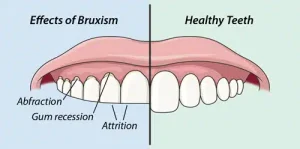 Act of gnashing and grinding of teeth.
Act of gnashing and grinding of teeth.
Common process in children or adults.
25-30% of children have this problem and one in twenty adults.
Equal incidence in the sexes.
Two types: nighttime and daytime grinding.
Nighttime grinding also known as nocturnal Bruxism is a back and forth, side to side movement of the lower teeth rubbing against the upper teeth.
Daytime grinding known as clenching refers to a rocking motion of the lower teeth against the upper teeth without side to side motion.
Clenching can occur both day and night.
Not part of normal chewing and swallowing.
While normal chewing applies about 25-50 lbs on back molar teeth bruxism creates forces as high as 250 lbs during sleep.
During nocturnal bruxism the upper and lower teeth come into contact as much as 40 minutes/hr of sleep compared to normal chewing of 25-30 minutes in a 12 hour day.
The force of and contact between the teeth can lead to dental conditions.
Parafunctional activities of clenching and grinding can be controlled by the individual during the day but with sleep this ability is lost.
Most adults grind during sleep at some time and it is probably a physiological release mechanism for stress.
As the duration and severity of grinding increases damage to teeth, bones, muscles and nerves can occur.
Patients may present with rhythmic crunching or grating noises at night, headaches and stiffness of the neck upon wakening, jaw muscle pain and tightness of the jaws, awakening with clenched teeth, pain in the temporomandibular joint, facial pains, ear pain, tinnitus, increased sensitivity of the teeth, wearing of the teeth, chipping or fractures of teeth, biting the inner cheeks and biting of the tongue, loosened teeth, inability to chew without jaw muscle tightening and fatigue, sleepiness during the day.
There is a strong correlation between bruxism and neuroticism.
Bruxism can cause migraine headaches.
